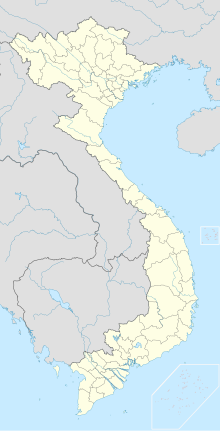
Nanzhao was a dynastic kingdom that flourished in what is now southern China and northern Southeast Asia during the 8th and 9th centuries. It was centered on present-day Yunnan in China.

The Đinh dynasty, officially Great Cồ Việt, was a Vietnamese dynasty. It was founded in 968 when Đinh Bộ Lĩnh vanquished the upheavals of Twelve warlords and ended when the son of Đinh Bộ Lĩnh, Đinh Toàn, ceded the throne to Lê Hoàn in 980.

Emperor Xizong of Tang, né Li Yan, later name changed to Li Xuan, was an emperor of China's Tang dynasty. He reigned from 873 to 888. He was the fifth son of his predecessor Emperor Yizong and was the elder brother of his successor Emperor Zhaozong. His reign saw his realm overrun by the great agrarian rebellions led by Wang Xianzhi and Huang Chao, and while both were eventually defeated, by the end of Emperor Xizong's reign, the Tang state had virtually disintegrated into pieces ruled by individual warlords, rather than the imperial government, and would never recover, falling eventually in 907.

Emperor Yizong of Tang, né Li Wen, later changed to Li Cui, was an emperor of the Tang dynasty of China. He reigned from 859 to 873. Emperor Yizong was the eldest son of Emperor Xuanzong. After Emperor Xuanzong's death in 859, Emperor Yizong was placed on the throne by the eunuch Wang Zongshi (王宗實), who killed other eunuchs supporting another son of Emperor Xuanzong, Li Zi the Prince of Kui.

Annan was an imperial protectorate and the southernmost administrative division of the Tang dynasty and Wu Zhou dynasty of China from 679 to 866, located in modern-day Vietnam. An Nam, simplified to "Annam", is the Vietnamese form of the Chinese name Annan, which means "the Pacified South" or "to pacify the South", a clipped form of the full name, the "Protectorate General to Pacify the South".
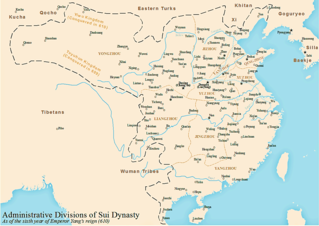
The Third Era of Northern Domination refers to the third period of Chinese rule in Vietnamese history. The era starts from the end of the Early Lý dynasty in 602 to the rise of the local Khúc family and other Viet warlords in the early 10th century, finally ending in 938 after the defeat of the Southern Han armada by the Viet leader Ngô Quyền. This period saw three Chinese imperial dynasties rule over what is today northern Vietnam: Sui, Tang and Wu Zhou. The Sui dynasty ruled northern Vietnam from 602 to 618, and briefly reoccupied central Vietnam in 605. The successive Tang dynasty ruled northern Vietnam from 621 to 690, and again from 705 to 880. Between 690 and 705, the Tang dynasty was briefly interrupted by the Wu Zhou dynasty which maintained Chinese rule over Vietnam.

Phùng Hưng was a chief and military leader who briefly reigned over Protectorate General to Pacify the South during the 8th century.
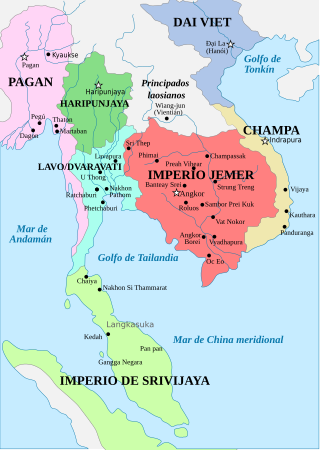
Đại Việt, often known as Annam, was a monarchy in eastern Mainland Southeast Asia from the 10th century AD to the early 19th century, centered around the region of present-day Hanoi, Northern Vietnam. Its early name, Đại Cồ Việt, was established in 968 by Vietnamese ruler Đinh Bộ Lĩnh after he ended the Anarchy of the 12 Warlords, until the beginning of the reign of Lý Thánh Tông, the third emperor of the Lý dynasty. Đại Việt lasted until the reign of Gia Long, the first emperor of the Nguyễn dynasty, when the name was changed to Việt Nam.
Gao Pian, courtesy name Qianli (千里), formally the Prince of Bohai (渤海王), was a Chinese military general, poet, and politician of the Tang dynasty. He initially gained renown for defeating Nanzhao incursions, but later became known for his failure to repel the rebel army under Huang Chao and his mismanagement of Huainan Circuit, which he governed as military governor (jiedushi). A rebellion against him in 887 resulted in intense internal warfare in Huainan Circuit and his imprisonment by Qin Yan, who eventually put him to death.
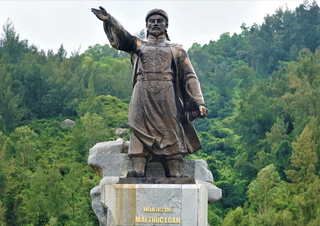
Mai Thúc Loan (or Mai Huyền Thành, self-proclaimed Mai Hắc Đế, was the Vietnamese leader of the uprising in 722 AD against the rule of the Chinese Tang dynasty in the provinces of Hoan Châu and Ái Châu. Regarded as one of the major rebellions during the Third Chinese domination, the uprising of Mai Thúc Loan succeeded in capturing the capital Songping of the Tang's Annan protectorate and Mai Thúc Loan thus proclaimed himself Mai Hắc Đế, the emperor of the independent region for a short time before being put down by the military campaign after the order of the Emperor Xuanzong of Tang. Today Mai Thúc Loan is praised as one of the early national heroes in the history of Vietnam who contributed for the struggle for independence of the country.
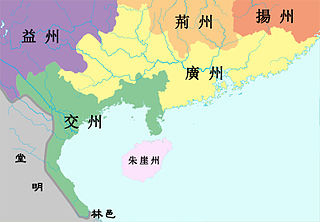
Jiaozhou was an imperial Chinese province under the Han and Jin dynasties. Under the Han, the area included Liangguang and northern Vietnam but Guangdong was later separated to form the province of Guangzhou by Sun Quan following the death of Shi Xie and lasted until the creation of the Annan Protectorate in 679.
Li Shenfu (李神福) was a general who served under the major warlord Yang Xingmi the military governor (Jiedushi) of Huainan Circuit late in the Chinese Tang Dynasty.

The Lam Sơn uprising was a Vietnamese rebellion led by Lê Lợi in the province of Jiaozhi from 1418 to 1427 against the rule of Ming China. The success of the rebellion led to the establishment of the Later Lê dynasty by Lê Lợi in Đại Việt.
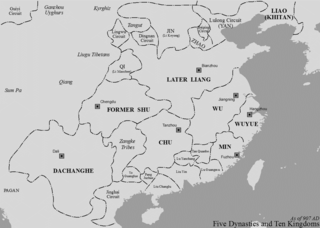
Tĩnh Hải quân or Jinghai Circuit, also known as Annam (安南), was an administrative division of the Tang dynasty of China administered by Chinese governors, which then later became a quasi-independent regime ruled by successive local Vietnamese warlords and monarchs. It was centered around what is now northern Vietnam from 866 to 967 during the late Tang period and lasted until the late Five Dynasties and Ten Kingdoms period when Đinh Bộ Lĩnh established the Đinh dynasty.

The military history of the Sui and Tang dynasties encompasses the period of Chinese military activity from 581 to 907. Although the Sui dynasty (581–618) preceded the Tang (618–907), it was extremely short lived, ending in 618. The two dynasties share many similar trends and behaviors in terms of military tactics, strategy, and technology. It can therefore be viewed that the Tang continued the Sui tradition, or that the Sui set the precedent for the Tang dynasty.
Liêu Hữu Phương, Chinese name Liao Yuqīng, was an poet and government official of the Tang dynasty during the early 9th century AD.
Zeng Gun was an officer of Chinese Tang dynasty, he served as the governor of the Jinghai polity in northern Vietnam from 878 to 880. Zeng Gun also had served Gao Pian during the Nanzhao war. During the years he lived in northern Vietnam, he had interests in local culture and spent years in collecting local folklore. His works include the story Mountain spirit and the Spirit of Cao Lỗ. Contributions of Zeng Gun and Zhao Chang later were cited by 14th century Vietnamese author Lý Tế Xuyên in Việt Điện U Linh Tập (1329).
Chu Đạo Cổ, known in Chinese as Zhu Daogu was a chieftain who allied with Nanzhao's generals Yang Sijin and Duan Qiuqian in the assault on the Tang-held city of Songping, capital of the Tang's Protectorate General to Pacify the South in early 863. After captured Songping, in June 863, Zhu Daogu commanded a local army of 2,000 men, with other 4,000 Yunnanese men and together rowing several hundred small boats, attacked the Tang stronghold of Chün-zhou. Zhu Daogu captured a Tang officer, but a commander from the headquarters of the governor-general counterattacked. The Tang dynasty took ten large sailing junks and war boats, and rammed the rebels' fleets and sank 30 boats. Three years later, in December 866 the Tang general Gao Pian recaptured Annan and had Zhu Daogu executed, along with other local rebel leaders.
Lý Do Độc, known in Chinese as Li Youdu was a chieftain of a tribe called Taohua and a rebel leader in Phong around mid-9th century, during the Third Chinese domination of Vietnam. Phong back then was the boundary area between Tang empire's Annan Protectorate and the kingdom of Nanzhao in modern-day Yunnan. Lý Do Độc himself commanding a local army of 6,000 and was assisted by seven "Lords of the Ravines."

Tang–Nanzhao conflicts in Annan was a period of intense chaos and warfare in Annan between local rebel forces, Nanzhao, and the Tang dynasty that lasted from 854 to 866. It ended in the defeat of Nanzhao and the retaking of Annan by the Tang general, Gao Pian, although the region would later become semi-independent from the Tang dynasty in 880.

